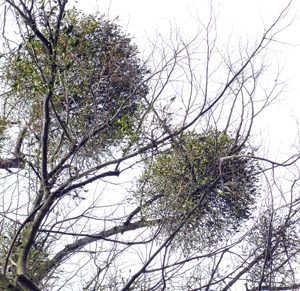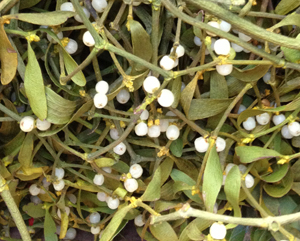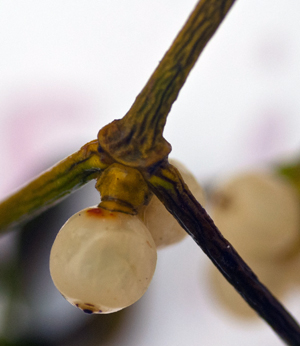A seasonal plant – Mistletoe.

Many evergreen plants are associated with Winter, and Christmas in particular - notably various fir trees as 'Christmas Trees', holly and ivy for decorations and wreaths, and mistletoe as the decoration under which lovers might kiss. For an interesting video on “The Botany of Christmas” visit Mark Nesbitt’s lecture to the Linnean Society.
Associations with Mistletoe go way back and there are a number of customs and myths surrounding the plant. Pliny wrote that it was collected by Druids - particularly from oak (believing that it held the soul of the host tree and it was to be cut from the trees with a golden sickle). Mistletoe has been used in folk / herbal medicine to treat various ailments - from cancer to epilepsy but clinical trials as to its effectiveness are needed. However, like many plants, mistletoe is actively being investigated for its phytochemicals and possible medical uses.
 Mistletoe (Viscum album) grows on other plants - notably apple, blackthorn, lime, willow and poplar; large balls of mistletoe may be seen suspended in these trees. Because of this, mistletoe is described as a parasite but because it has evergreen, smooth-edged, oval leaves that photosynthesise, it is actually a partial parasite or hemiparasite. So, it can make sugars and other complex organic compounds but it relies on the host plant for water and mineral salts. It does this by forming ‘clamp-like’ connections (known as haustoria) with the water conduction tissue (xylem tissue) of the host plant. The water moving through the host plant also contains a number of mineral ions (nitrates, phosphates, potassium etc.)
Mistletoe (Viscum album) grows on other plants - notably apple, blackthorn, lime, willow and poplar; large balls of mistletoe may be seen suspended in these trees. Because of this, mistletoe is described as a parasite but because it has evergreen, smooth-edged, oval leaves that photosynthesise, it is actually a partial parasite or hemiparasite. So, it can make sugars and other complex organic compounds but it relies on the host plant for water and mineral salts. It does this by forming ‘clamp-like’ connections (known as haustoria) with the water conduction tissue (xylem tissue) of the host plant. The water moving through the host plant also contains a number of mineral ions (nitrates, phosphates, potassium etc.)
 A mistletoe seed germinates on a branch of a host tree or shrub. It probably arrives there by a bird wiping its beak on the bark - because it has eaten one of the white berries of a mature mistletoe plant. The white berries (known as drupes) form in the winter months and are often taken by birds. However, the tissue around the seeds is sticky / viscid. So, a bird (such as a blackcap) will scrape off the seed from its beak onto the bark of a tree, where it may germinate. The stickiness may also help stick the seed to a possible host. The sticky nature of the fruit is due to a mixture of cellulosic strands and mucopolysaccharides.
A mistletoe seed germinates on a branch of a host tree or shrub. It probably arrives there by a bird wiping its beak on the bark - because it has eaten one of the white berries of a mature mistletoe plant. The white berries (known as drupes) form in the winter months and are often taken by birds. However, the tissue around the seeds is sticky / viscid. So, a bird (such as a blackcap) will scrape off the seed from its beak onto the bark of a tree, where it may germinate. The stickiness may also help stick the seed to a possible host. The sticky nature of the fruit is due to a mixture of cellulosic strands and mucopolysaccharides.
The centre of mistletoe ‘cultivation’ in the UK is along the English / Welsh border, and several tonnes are sold through auctions at Tenbury Wells ; but mistletoe is also imported from Europe.
For further information on mistletoe visit mistletoe.org.uk.
Comments are closed for this post.

Mistletoe also has a small but important starring role in old Norse mythology – it caused the death of the God of peace and wisdom, Balder. Every other plant, animal and thing on earth had promised not to harm Balder, but they ignored the mistletoe as it seemed too insignificant. The evil half-God Loki learns about the omission and gives the blind God Hødd an arrow made from mistletoe..
Hallvord R. M. Steen
4 January, 2017